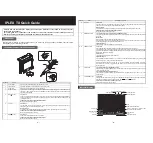
Appendix E: Equivalent-Time (ET) oscilloscope operation
1.
Set up all of the connections for your anticipated measurement. Connect to
the receiver using the LRCP and turn on the sources you require. Verify that
the oscilloscope is set up correctly.
2.
Disconnect the Signal Input to the receiver, so that only the Reference (LO) is
present.
3.
Click the
DC calibration
button on the Setup Ribbon. This initiates a process
which determines the DC levels in the receiver’s photodiodes, and subtracts
this value during analysis.
4.
Reconnect the Signal Input.
This can be done as often as needed or desired. If there is uncompensated dc
offset in the system, this will be evident by a smearing out of the constellation
point groups. If the offset is large enough, the point groups will begin to look like
donuts. Perform a dc calibration whenever there is any question.
Homodyne detection, which is assumed when using the software in
equivalent-time mode, creates special dif
fi
culty for dc offset measurement
since a homodyne signal can have an important dc component. This is why the
Input Signal is disconnected in the procedure. However, if the Input Signal is
comparable in magnitude to the Reference Input, the above procedure will not
remove all of the dc-offset
Delay adjustment (system
deskew) (ET)
NOTE.
Initial delay adjustment should be done by trained personnel. This section
is provided for experienced users. Delay adjustment should be done during
installation and should not require attention unless the scope is removed and/or
reconnected.
Delay adjustment among the four electrical channels of the oscilloscope is done
through the sliders on the ET Scope Service Utility (SSU) running on the ET
oscilloscope.
Click the button corresponding to the mainframe channels for the
sampler-to-receiver connections. Channels 5:8 are the default selection because
these are closer to the OM4000 inputs.
OM4000D Series Coherent Lightwave Signal Analyzer
131
Summary of Contents for OM4006D
Page 2: ......
Page 6: ......
Page 22: ...Compliance information xvi OM4000D Series Coherent Lightwave Signal Analyzer...
Page 24: ...Preface xviii OM4000D Series Coherent Lightwave Signal Analyzer...
Page 100: ...Taking measurements 76 OM4000D Series Coherent Lightwave Signal Analyzer...
Page 146: ...Appendix D Automatic receiver deskew 122 OM4000D Series Coherent Lightwave Signal Analyzer...
Page 202: ...Appendix H Cleaning and maintenance 178 OM4000D Series Coherent Lightwave Signal Analyzer...
Page 205: ...Index W Waveform averaging 48 OM4000D Series Coherent Lightwave Signal Analyzer 181...
















































